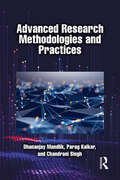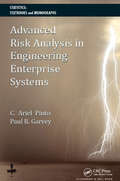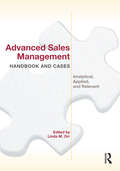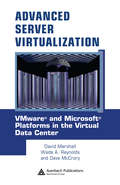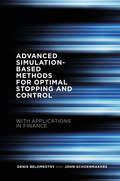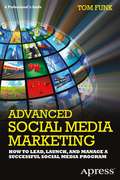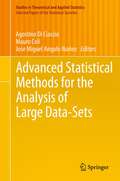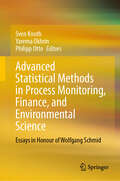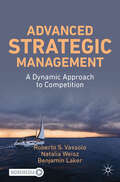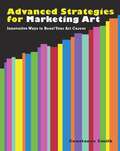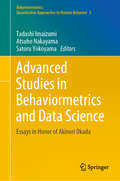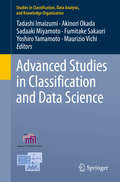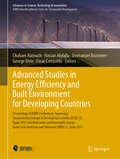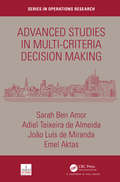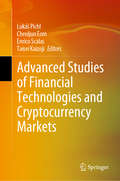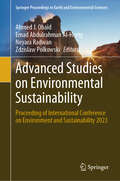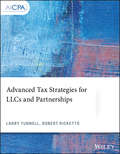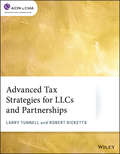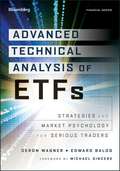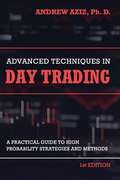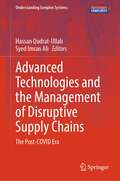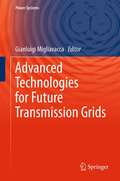- Table View
- List View
Advanced Research Methodologies and Practices
by Chandrani Singh Dhananjay Mandlik Parag KalkarThis comprehensive textbook is designed to equip researchers, academics, and students with the essential tools and knowledge needed to conduct advanced research across various disciplines.The book addresses crucial aspects of research dissemination and publication, offering insights into scholarly writing, manuscript preparation, and the peer review process, empowering researchers to effectively communicate their findings and contribute to their respective fields. It covers salient topics such as formulating research questions, designing research studies, and selecting appropriate research methodologies. It emphasizes the importance of rigorous and ethical research practices and explores strategies for conducting literature reviews and synthesizing existing knowledge. It also delves into advanced quantitative and qualitative research methods, offering detailed explanations of statistical analyses, data collection techniques, and sampling strategies.Throughout the book, real-world examples, case studies, and practical exercises are integrated to enhance understanding and application of the concepts discussed to equip the readers with the knowledge, skills, and confidence to push the boundaries of knowledge and make a lasting impact. It will serve as an invaluable resource for students, researchers, academics, and industry professionals seeking to enhance their research skills and elevate the quality and impact of their scholarly work.
Advanced Risk Analysis in Engineering Enterprise Systems (Statistics: A Series of Textbooks and Monographs)
by Cesar Ariel Pinto Paul R. GarveySince the emerging discipline of engineering enterprise systems extends traditional systems engineering to develop webs of systems and systems-of-systems, the engineering management and management science communities need new approaches for analyzing and managing risk in engineering enterprise systems. Advanced Risk Analysis in Engineering Enterpri
Advanced Sales Management Handbook and Cases: Analytical, Applied, and Relevant
by Linda M OrrAdvanced Sales Management Handbook and Cases: Analytical, Applied, and Relevant will fill the need in the market for a solid case work, role play, and activity book. It has been written by sales teaching professionals and sales executives. The life experiences of professionals with varied experiences will provide students with a solid foundation for learning. This will give college professors from around the world a better opportunity to ensure quality of learning. The book is intended to be supplemental to any other sales management text on the market, but could be used alone in an advanced sales management or marketing analytics course in which the students already have the base theoretical knowledge. The various cases, role plays, and experiential exercises in this book will follow the same topical structure of other sales management texts so that any sales management instructor can readily adopt this supplemental book. For many of the cases, actual data has been given so that students are required to use and understand analytical software.
Advanced Server Virtualization: VMware and Microsoft Platforms in the Virtual Data Center
by David Marshall Wade A. Reynolds Dave McCroryPresenting practical guidelines and examples, Advanced Server Virtualization emphasizes design, implementation, and management from both a technical and consultative point of view. It features step-by-step guidelines for planning, deployment, installing, configuring, and creating virtual servers. Covering Microsoft Virtual Server and VMware, it addresses platform-specific virtualization features such as virtual machines, hard drives, networking, and resource management. It offers best practices that allow users to avoid common pitfalls and achieve success faster during server virtualization implementations. It also discusses software licensing issues and the cost-benefits of deploying virtual servers.
Advanced Simulation-Based Methods for Optimal Stopping and Control: With Applications in Finance
by Denis Belomestny John SchoenmakersThis is an advanced guide to optimal stopping and control, focusing on advanced Monte Carlo simulation and its application to finance. Written for quantitative finance practitioners and researchers in academia, the book looks at the classical simulation based algorithms before introducing some of the new, cutting edge approaches under development.
Advanced Social Media Marketing: How to Lead, Launch, and Manage a Successful Social Media Program
by Tom FunkThey are laborers, soldiers, refugees, and orphans. In areas of the world torn by poverty, disease, and war, millions of children are invisible victims, deprived of home, family, and basic human rights. Their chances for a stable adult life are extremely slim. The powerful interdisciplinary volume Vulnerable Children brings a global child-rights perspective to the lives of indigenous, refugee, and minority children in and from?crisis-prone regions. Focusing on self-determination, education, security, health, and related issues, an international panel of scholars examines the structural and political sources of children''s vulnerabilities and their effects on development. The book analyzes intervention programs currently in place and identifies challenges that must be met at both the community and larger policy levels. These chapters also go a long way to explain the often-blurred line between vulnerability and resilience. Included in the coverage: Dilemmas of rights-based approaches to child well-being in an African cultural context. Poverty and minority childrenOCOs education in the U. S. : case study of a Sudanese refugee family. The heterogeneity of young childrenOCOs experiences in Kenya and Brazil. A world tour of interventions for children of a parent with a psychiatric illness. An exploration of fosterage of Owambo orphans in Namibia. UNICEF in Colombia: defending and nurturing childhood in media, public, and policy discourses. Vulnerable Children is a must-have volume for researchers, graduate students, and clinicians/professionals/practitioners across a range of fields, including child and school psychology, social work, maternal and child health, developmental psychology, anthropology, sociology, social policy, and public health"
Advanced Statistical Methods for the Analysis of Large Data-Sets (Studies in Theoretical and Applied Statistics)
by Jose Miguel Angulo Ibanez Mauro Coli Agostino Di CiaccioThe theme of the meeting was "Statistical Methods for the Analysis of Large Data-Sets". In recent years there has been increasing interest in this subject; in fact a huge quantity of information is often available but standard statistical techniques are usually not well suited to managing this kind of data. The conference serves as an important meeting point for European researchers working on this topic and a number of European statistical societies participated in the organization of the event. The book includes 45 papers from a selection of the 156 papers accepted for presentation and discussed at the conference on "Advanced Statistical Methods for the Analysis of Large Data-sets."
Advanced Statistical Methods in Process Monitoring, Finance, and Environmental Science: Essays in Honour of Wolfgang Schmid
by Sven Knoth Philipp Otto Yarema OkhrinThis book presents a unique collection of contributions on modern methods and applications in three key areas of statistics, celebrating the significant work of Wolfgang Schmid in this field. It is structured thematically into parts focusing on statistical process monitoring, financial statistics, and spatial statistics with environmetrics, each featuring chapters from leading experts. The opening articles on statistical process monitoring present novel methodologies for the detection of anomalies and control charting techniques, which are crucial for maintaining quality in manufacturing processes. Detailed discussions are included on integrating multivariate statistical methods and real-time monitoring to enhance process reliability and efficiency. The part on financial statistics explores rigorous approaches in financial econometrics, with an emphasis on dynamic modelling of market volatility and risk assessment. Contributions cover advanced asset allocation strategies, leveraging high-dimensional data analysis, and the application of machine learning techniques. Spatial statistics and environmetrics are addressed through innovative research on the statistical analysis of environmental data. This includes the use of geostatistical models and hybrid models that combine traditional statistical techniques with machine learning to improve the prediction of environmental phenomena. Key topics here involve the modelling of extremes and airborne pollutants, the prediction of earthquakes using a smartphone-based sensor network, and reviews of selected topics essential in modern spatial statistics. Each part not only reflects Wolfgang Schmid’s interests and impact in these areas but also provides detailed theoretical and applied studies, demonstrating how these sophisticated statistical methods can be effectively employed in practical scenarios. This makes the book an indispensable resource for researchers and practitioners looking to apply cutting-edge statistical techniques in these complex fields.
Advanced Strategic Management: A Dynamic Approach to Competition
by Roberto S. Vassolo Natalia Weisz Benjamin LakerAdvanced Strategic Management offers a distinctive evolutionary perspective, unveiling consistent processes that shape competitive dynamics. It goes beyond traditional boundaries, exploring evolutionary trends across industry life cycles, commodity cycles, and the business cycle. Seamlessly integrating analyses of environmental trends and the transformative impact of the digital revolution, the book underscores the crucial role of regulations and taxes in influencing firm-level performance.A key strength lies in its holistic coverage, encompassing core elements of competitive and corporate strategy while delving deeper into advanced models and tools for strategic evaluation, formulation, and implementation. This depth equips readers, including future business leaders, with a profound understanding of competitive dynamics.The book's unique approach integrates strategic management with adaptive leadership, offering readers a comprehensive and practical perspective rooted in extensive research and international case examples. This approach ensures global relevance.Instructors will find the book's wealth of examples, tables, figures, and references invaluable for class preparation. The abundance of statistical data facilitates students' comprehension of evolutionary forces and their impact on competition and performance. The structured pedagogy streamlines teaching, and the addition of PowerPoint slides further enhances its educational utility.In summary, Advanced Strategic Management is a comprehensive, globally aware, and practically oriented resource that bridges the gap between theory and application. Its innovative approach and rich content make it an indispensable tool for students, educators, and practitioners navigating the complexities of modern strategic management.
Advanced Strategies for Marketing Art
by Constance SmithEducating oneself in all aspects of marketing is a necessity for any emerging or established artist. In this new book, artists will be taught to think about innovative and genre-specific marketing venues that they otherwise never would have explored.Names and websites of prominent and established art world professionals in a variety of venues are noted. Advance tax issues that will help artists save money are addressed, as well as advertising venues and direct mail innovations. Exposing your artwork online is discussed in detail, including how to develop a profitable and respectful website. Detailed information on how to approach a gallery owner and how to find a rep is also included. Information on art retreats and workshops is covered.Several prominent art world professionals have added their two cents in a variety of articles throughout the chapters, giving direct insight into how art professionals think and work. If you are a working, professional, exhibiting artist, you can't pass up this book, which will take you to new levels in your career.
Advanced Studies in Behaviormetrics and Data Science: Essays in Honor of Akinori Okada (Behaviormetrics: Quantitative Approaches to Human Behavior #5)
by Tadashi Imaizumi Atsuho Nakayama Satoru YokoyamaThis book focuses on the latest developments in behaviormetrics and data science, covering a wide range of topics in data analysis and related areas of data science, including analysis of complex data, analysis of qualitative data, methods for high-dimensional data, dimensionality reduction, visualization of such data, multivariate statistical methods, analysis of asymmetric relational data, and various applications to real data. In addition to theoretical and methodological results, it also shows how to apply the proposed methods to a variety of problems, for example in consumer behavior, decision making, marketing data, and social network structures.Moreover, it discuses methodological aspects and applications in a wide range of areas, such as behaviormetrics; behavioral science; psychology; and marketing, management and social sciences. Combining methodological advances with real-world applications collected from a variety of research fields, the book is a valuable resource for researchers and practitioners, as well as for applied statisticians and data analysts.
Advanced Studies in Classification and Data Science: Proceedings Of The 6th Conference Of The International Federation Of Classification Societies (ifcs-98) Università La Sapienza , Rome, 21-24 July 1998 (Studies in Classification, Data Analysis, and Knowledge Organization)
by Akinori Okada Maurizio Vichi Tadashi Imaizumi Sadaaki Miyamoto Fumitake Sakaori Yoshiro YamamotoThis edited volume focuses on the latest developments in classification and data science and covers a wide range of topics in the context of data analysis and related areas, e.g. the analysis of complex data, analysis of qualitative data, methods for high-dimensional data, dimensionality reduction, data visualization, multivariate statistical methods, and various applications to real data in the social sciences, medical sciences, and other disciplines. In addition to sharing theoretical and methodological findings, the book shows how to apply the proposed methods to a variety of problems — e.g. in consumer behavior, decision-making, marketing data and social network structures. Both methodological aspects and applications to a wide range of areas such as economics, behavioral science, marketing science, management science and the social sciences are covered. The book is chiefly intended for researchers and practitioners who are interested in the latest developments and practical applications in these fields, as well as applied statisticians and data analysts. Its combination of methodological advances with a wide range of real-world applications gathered from several fields makes it of unique value in helping readers solve their research problems.
Advanced Studies in Energy Efficiency and Built Environment for Developing Countries: Proceedings of IEREK Conferences: Improving Sustainability Concept in Developing Countries (ISCDC-2), Egypt 2017 and Alternative and Renewable Energy Quest in Architecture and Urbanism (AREQ-2), Spain 2017 (Advances in Science, Technology & Innovation)
by Chaham Alalouch Hassan Abdalla Emmanuel Bozonnet George Elvin Oscar CarracedoThis edited volume consists of three parts. It is a culmination of selected research papers presented at the second version of the international conference on Improving Sustainability Concept in Developing Countries (ISCDC) and the second version of the international conference on Alternative and Renewable Energy Quest in Architecture and Urbanism (AREQ), organized by IEREK in Egypt, 2017. It discusses major environmental issues and challenges which threaten our future. These include climate change impact, environmental deterioration, increasing demand for energy and new approaches for alternative renewable energy sources which became a necessity for survival. In addition to addressing the different environmental issues witnessed today, research presented in this book stressed on the need of sustainably shaping buildings and cities using renewable energy sources. Topics included in this book are (1) Resilience in the Built Environment, (2) Design for energy-efficient architecture and (3) Alternative and Renewable Energy Resources Quest in Architecture and Urbanism. The book is of interest to researchers and academicians who continuously aim to update their knowledge in these fields, as well as decision makers needing the enough knowledge to carry out the right decisions towards the benefit of the environment and society.
Advanced Studies in Multi-Criteria Decision Making (Chapman & Hall/CRC Series in Operations Research)
by Emel Aktas Sarah Ben Amor Adiel Teixeira De Almeida Joao Luis De MirandaWith contributions from some of the top academics and scientists in the field, Advanced Studies in Multi-Criteria Decision Making presents an updated view of the landscape of Decision Sciences, current research topics, the interaction with other sciences and fields, as well as the prospects and challenges at an international level. Given that Decision Sciences are recognized today as indispensable for confronting the major societal challenges in science and technology, this book would be of interest to decision-makers, managers, and researchers from academia, and industrial/services companies that would like a fresh insight into MCDM. Features Integrates a wide range of scientific fields with a general reader approach, including applied researchers from the social, business, enterprise sciences Suitable for academics and professionals Presents a broad coverage of MCDM tools either in industry or in services companies and systems Provides a fresh overview on MCDM studies promoted by prestigious R&D institutions
Advanced Studies of Financial Technologies and Cryptocurrency Markets
by Lukáš Pichl Taisei Kaizoji Cheoljun Eom Enrico ScalasThis book shows that research contributions from different fields—finance, economics, computer sciences, and physics—can provide useful insights into key issues in financial and cryptocurrency markets. Presenting the latest empirical and theoretical advances, it helps readers gain a better understanding of financial markets and cryptocurrencies. Bitcoin was the first cryptocurrency to use a peer-to-peer network to prevent double-spending and to control its issue without the need for a central authority, and it has attracted wide public attention since its introduction. In recent years, the academic community has also started gaining interest in cyptocurrencies, and research in the field has grown rapidly. This book presents is a collection of the latest work on cryptocurrency markets and the properties of those markets. This book will appeal to graduate students and researchers from disciplines such as finance, economics, financial engineering, computer science, physics and applied mathematics working in the field of financial markets, including cryptocurrency markets.
Advanced Studies on Environmental Sustainability: Proceeding of International Conference on Environment and Sustainability 2023 (Springer Proceedings in Earth and Environmental Sciences)
by Zdzislaw Polkowski Ahmed J. Obaid Emad Abdulrahman Al-Heety Neyara RadwanThis proceedings book of ICES 2023 presents the most recent studies on environmental sciences and environmental sustainability, which contributes to the resolution of environmental issues (air pollution, water pollution, soil pollution, noise pollution, thermal pollution, radioactive pollution, light pollution, and global warming). The discharge of environmental pollutants from industrial, commercial, residential, and sensible locations must be handled with care, since it may harm the air, water, and land if not adequately treated. As a result of the enormous volume of wastewater and environmental pollution generated daily, the majority of designs and developments of wastewater technologies and environmental treatment were unable to handle the load. This is a threat to sustainable growth, and it must be resolved in a precise, dependable, urgent, and timely manner. Sustainable creative and technical transfer approaches that can be utilized for supporting, operationalizing, and providing sustainable wastewater and environmental treatment solutions are of interest to us. The authors hope that the book covers the possible spectrum of wastewater technologies and environmental treatment up to a high level of environmental protection, clean and green management lessons, identify the barriers to transformational change, and then inform the agenda and initiatives for sustainable development. ICES 2023 is devoted to wastewater technology and environmental treatment, with an emphasis on environmental protection at the highest level. ICES 2023 aims to disseminate current knowledge and sustainable development, share experience and lessons gained, and generate conversation and reflection in order to promote a paradigm shift that is sustainable. With the distribution of sustainable wastewater technology and environmental treatment, the ultimate goal is to bring revolutionary change to sustainable development.
Advanced Tax Strategies for LLCs and Partnerships (AICPA)
by Larry Tunnell Robert RickettsAdvanced Tax Strategies for LLCs and Partnerships
Advanced Tax Strategies for LLCs and Partnerships (AICPA)
by Larry Tunnell Robert RickettsAre you ready to master the advanced concepts of partnership taxation? Provide your clients with valuable advice and tax planning strategies and gain a working knowledge of the Internal Revenue Code's sophisticated partnership tax rules and regulations. This book takes a deep dive into the complexities of partnership tax law. It includes step-by-step examples to help guide you through the complicated world of advanced partnership and LLC tax law. Some of the many concepts covered in this course include special allocations, liquidating and non-liquidation distributions, property basis calculations under various scenarios, and sales of a partnership interest.
Advanced Technical Analysis of ETFs
by Deron Wagner Edward BalogA comprehensive book filled with technical analysis tools and strategies for the advanced ETF trader Advanced Technical Analysis of ETFs is an important resource for sophisticated ETF traders that contains a wealth of expanded strategies for technical trade setups and includes the author's best real trade examples (both winning and losing), as well as additional user-friendly technical indicators. Step by step this book offers you a how-to guide for profiting from ETFs through a unique strategy of technical analysis that was outlined in Wagner's previous book and summarized in the introduction. The strategy is designed to compare relative strength using a top-down approach. In this book, Wagner focuses on new indicators not previously covered including candlesticks (Doji, Hammers, Hanging Man), Fibonacci, and others. He also explores essential new developments on moving average divergence/convergence (MACD), and institutional trading impact and how these elements now exert influence on the market. A vital resource written for ETF traders who are ready for the next level of sophistication Contains the author's signature "my best and worst trades" with real examples from his daily trading at a hedge fund Includes case studies that focus on the technical indicators outlined in the book Explores the role of market psychology for technical analysis traders and his trademark slogan, "Trade what you see, not what you think" Written in a straightforward and accessible style, this book will help sophisticated traders make the most of today's ETFs.
Advanced Techniques In Day Trading: A Practical Guide To High Probability Strategies And Methods (Day Trading)
by Andrew AzizThis well-thought-out training regimen begins with an in-depth look at the necessary tools of the trade including your scanner, software and platform; and then moves to practical advice on subjects such as how to find the right stocks to trade, how to define support and resistance levels, and how to best manage your trades in the stress of the moment. <p><p> An extensive review of proven trading strategies follows, all amply illustrated with real examples from recent trades. Risk management is addressed including tips on how to determine proper entry, profit targets and stop losses. Lastly, to bring it all together, there's a "behind the scenes" look at the author's thought process as he walks you through a number of trades. While aimed at the reader with some exposure to day trading, the novice trader will also find much useful information, easily explained, on the pages within.
Advanced Technologies and the Management of Disruptive Supply Chains: The Post-COVID Era (Understanding Complex Systems)
by Hassan Qudrat-Ullah Syed Imran AliThe book explores cost-effective and efficient supply chain management to achieve resilience in the post-COVID environment. Qualitative, quantitative, case studies, and systematic literature reviews are made in the book. The book follows a didactic approach through which it informs global researchers and practitioners to deal with the most significant insights on future supply chains with a more in-depth analysis of post-COVID opportunities and challenges. In particular, this book provides an in-depth assessment of disruptive supply chain management in certain industrial contexts and explores various Industry 4.0 and Industry 5.0 technologies to achieve resilience. The book is used as a supplemental textbook for study within university level programs, at late undergraduate and graduate levels, in faculties of business and management, engineering systems, information systems, education, and computing.
Advanced Technologies for Future Transmission Grids (Power Systems)
by Gianluigi MigliavaccaThe re-engineering of power transmission systems is crucial to meeting the objectives of such regulators as the European Union. In addition to its market, organisational and regulatory aspects, this re-engineering will also involve technical issues dealing with the progressive integration of innovative transmission technologies in the daily operation of transmission system operators. In this context, Advanced Technologies for Future Transmission Grids provides an overview of the most promising technologies, likely to be of help to planners of transmission grids in responding to the challenges of the future: security of supply; integration of renewable generation; and creation of integrated energy markets (using the European case as an example). These issues have increased importance because of administrative complication and the fragmentation of public opinion expressed on the build up of new infrastructure. For each technology discussed, the focus is on the technical-economic perspective rather than on purely technological points of view. A transmission-system-operator-targeted Technology Roadmap is presented for the integration of promising innovative power transmission technologies within power systems of the mid-long term. Although the primary focus of this text is in the sphere of the European energy market, the lessons learned can be generalized to the energy markets of other regions.
Advanced Technologies, Inc.
by Thomas R. PiperThe CEO of a semiconductor equipment manufacturer is assessing the financial forecasts and financing plan prepared by the chief financial officer. Continued rapid growth will create substantial financing pressures, especially if profitability fails to recover and/or if a major, unexpected economic downturn occurs.
Advanced Technology for Smart Environment and Energy (Environmental Science and Engineering)
by Jamal Mabrouki Azrour Mourade Azeem Irshad Shehzad Ashraf ChaudhryThis book presents smart energy management in the context of energy transition. It presents the motivation, impacts and challenges related to this hot topic. Then, it focuses on the use of techniques and tools based on artificial intelligence (AI) to solve the challenges related to this problem. A global diagram presenting the general principle of these techniques is presented. Then, these techniques are compared according to a set of criteria in order to show their advantages and disadvantages with respect to the conditions and constraints of intelligent energy management applications in the context of energy transition. Several examples are used throughout the white paper to illustrate the concepts and methods presented. An intelligent electrical network (smart grid—SG) includes heterogeneous and distributed electricity production, transmission, distribution and consumption components. It is the next generation of electricity network able to manage electricity demand (consumption/production/distribution) in a sustainable, reliable and economical way taking into account the penetration of renewable energies (solar, wind, etc.). Therefore, a (SG) smart grid also includes an intelligent layer that analyzes the data provided by consumers as well as that collected from the production side in order to optimize consumption and production according to weather conditions, the profile and habits of the consumer. In addition, this system can improve the use of green energy through renewable energy penetration and demand response.
Advanced Technology for Smart Environment and Energy (Environmental Science and Engineering)
by Jamal Mabrouki Azrour MouradeThis book presents smart energy management in the context of energy transition. It presents the motivation, impacts and challenges related to this hot topic. Then, it focuses on the use of techniques and tools based on artificial intelligence (AI) to solve the challenges related to this problem. A global diagram presenting the general principle of these techniques is presented. Then, these techniques are compared according to a set of criteria in order to show their advantages and disadvantages with respect to the conditions and constraints of intelligent energy management applications in the context of energy transition. Several examples are used throughout the white paper to illustrate the concepts and methods presented. An intelligent electrical network (Smart grid—SG) includes heterogeneous and distributed electricity production, transmission, distribution and consumption components. It is the next generation of electricity network able to manage electricity demand (consumption/production/distribution) in a sustainable, reliable and economical way taking into account the penetration of renewable energies (solar, wind, etc.). Therefore, an SG smart grid also includes an intelligent layer that analyzes the data provided by consumers as well as that collected from the production side in order to optimize consumption and production according to weather conditions, the profile and habits of the consumer. In addition, this system can improve the use of green energy through renewable energy penetration and demand response.
